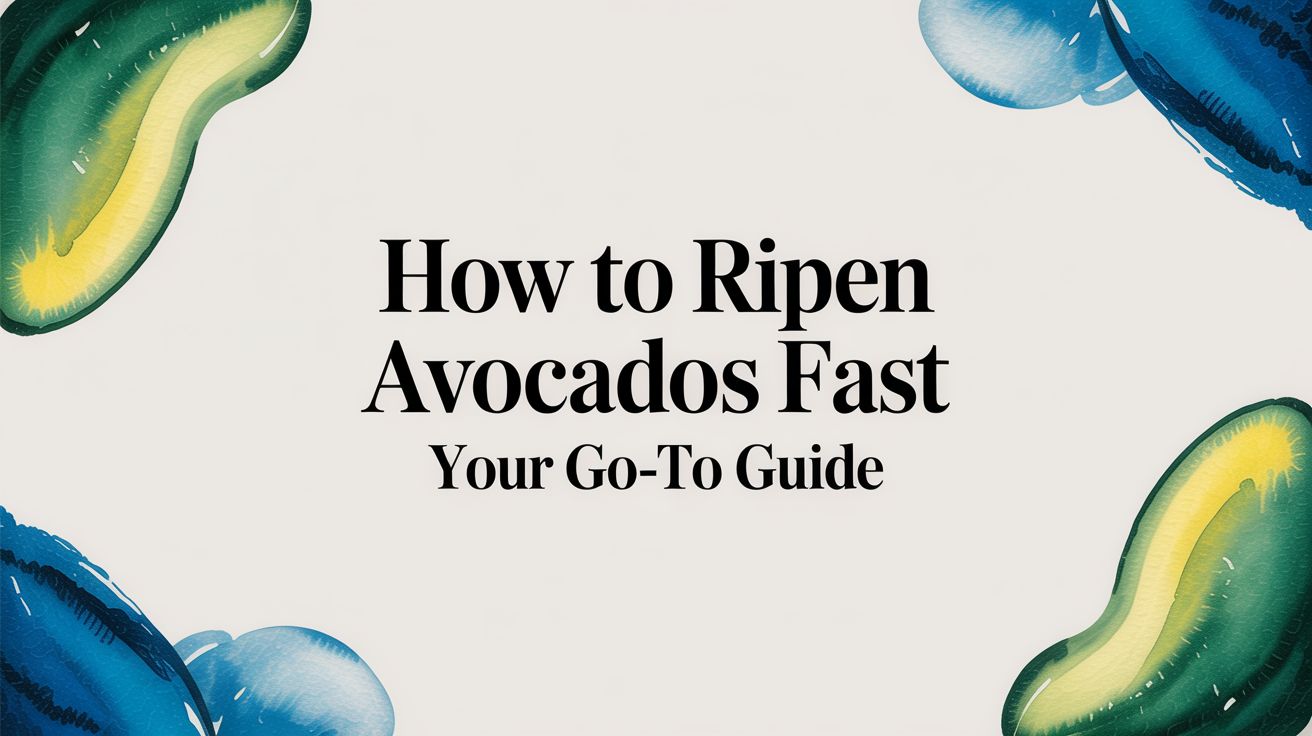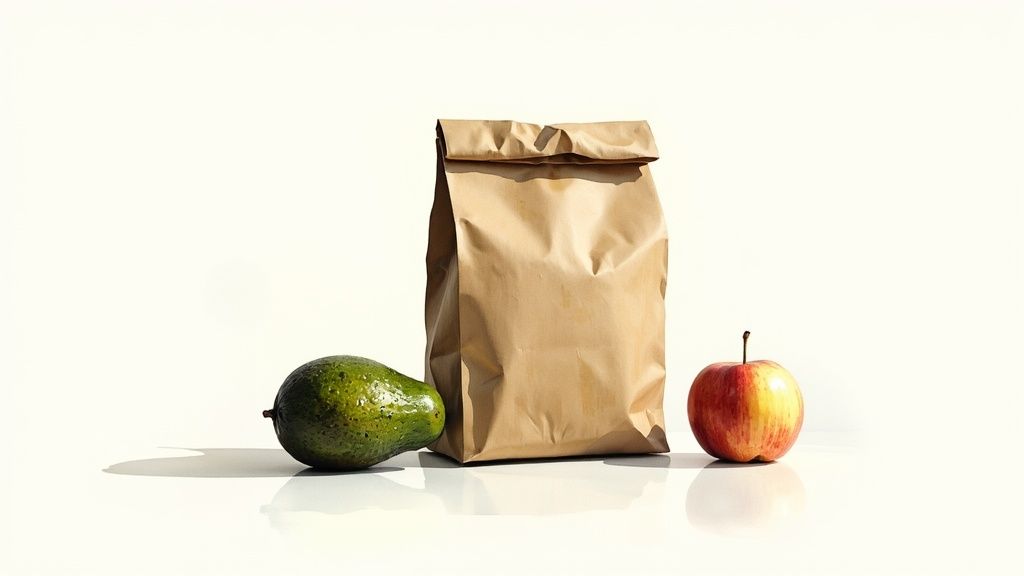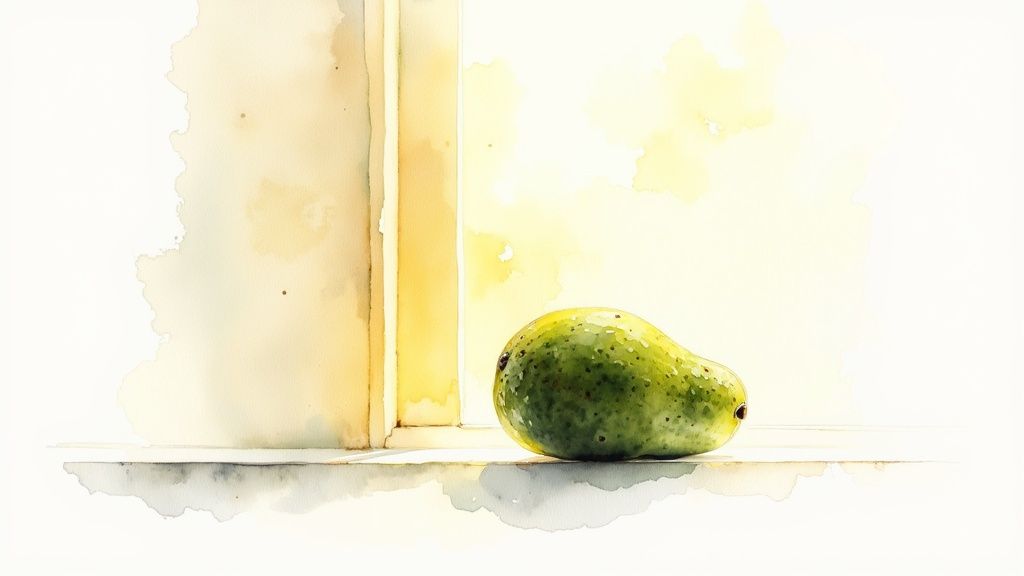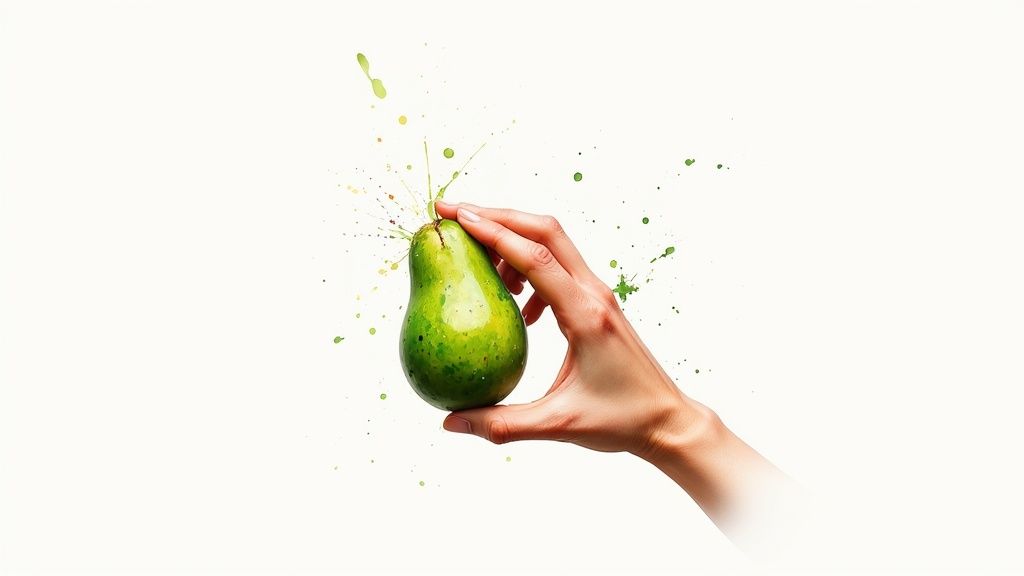
How to Ripen Avocados Fast Your Go-To Guide
To get an avocado to ripen quickly, your best bet is to pop it in a paper bag with a banana or an apple. This clever trick traps the ethylene gas that the fruit naturally gives off. Ethylene is a plant hormone that signals ripening, and concentrating it can get your avo ready in as little as 24-48 hours.
Why Your Avocados Are Still Rock-Hard
We’ve all been there. You cut into an avocado you’ve been patiently watching for days, only to find it’s still stubbornly firm and completely unusable. It’s a classic Kiwi kitchen frustration, but understanding why it happens is the first step to making sure it never happens again.
The whole secret is in a gas you can’t even see.
Avocados, much like bananas and apples, are what’s known as climacteric fruits. This just means they keep ripening long after they’ve been picked from the tree, all thanks to a burst of ethylene gas they produce. When an avocado is just sitting on your bench, that gas slowly dissipates, which is why ripening can take ages.
The real challenge? Most avocados you buy from the supermarket here in New Zealand are sold deliberately underripe. This makes them tough enough to survive the journey from the orchard to the shelf without turning to mush.
The Science of Softening
So, how do you speed things up? It's surprisingly simple: you just need to concentrate that ethylene gas right around the avocado. By trapping the gas, you create a little ripening bubble that accelerates the natural chemical reactions inside. This is what breaks down the starches into sugars and turns that hard, pale flesh into the creamy green goodness we're all after. It's the science behind every effective at-home method.
Not sure what to do with the avo you've got? This little decision tree should help point you in the right direction.

As you can see, if your avocado isn't quite there yet, the goal is always to kickstart that natural ripening cycle.
Take Control of Your Ripening Timeline
Instead of just hoping for the best, you can actually manage your avocado’s ripening timeline to fit your meal plans. No more guacamole plans getting derailed by a rock-hard avo. This guide will walk you through the proven techniques that put you back in control.
By understanding how ethylene works, you can turn a five-day wait into an overnight success. It's less about magic and more about mastering a bit of fruit science in your own kitchen.
Of course, growing your own produce gives you an even deeper appreciation for these natural cycles. If you're keen to get your hands dirty, learning the basics of gardening is a fantastic place to start. You can explore a practical course on home food gardening to build your confidence from the ground up.
Now, let’s get into the specific, actionable methods to get that perfectly creamy avocado, right when you need it.
The Paper Bag Method for Reliable Ripening

This classic technique is a favourite in Kiwi kitchens for a simple reason: it just works. The paper bag method is a foolproof way to naturally speed things up without any fuss. It creates the perfect little micro-environment for your avocado to soften, often turning a rock-hard fruit into a creamy delight in just a day or two.
The magic is all about concentrating the avocado's own ethylene gas. By popping the avo inside a paper bag, you trap this natural ripening hormone, surrounding the fruit and encouraging it to soften much faster than it would just sitting on the kitchen bench.
Why Paper Beats Plastic
You might be tempted to grab a plastic bag, but that's a common mistake. Plastic traps moisture right along with the ethylene, which can quickly lead to mould and a mushy, unpleasant texture. Nobody wants that.
A simple brown paper bag, on the other hand, is breathable. It keeps just enough ethylene concentrated around the avocado to do its job while letting excess moisture escape. This balance is the secret to achieving that perfect, creamy consistency without risking spoilage.
Give Your Avocado a Fruity Friend
To really put the pedal to the metal, give your avocado a companion. Adding an apple or a banana to the bag is one of the most effective tricks in the book. These fruits are ethylene-producing powerhouses and will flood the bag with the ripening gas, supercharging the whole process.
Here’s what you can add to the bag:
- A ripe banana: Bananas are famous for releasing high amounts of ethylene, making them an excellent choice.
- An apple (any variety works): Apples are also strong ethylene producers and work just as well.
- A kiwifruit or tomato: If you don't have bananas or apples on hand, these also release enough ethylene to help out.
Once your avocado is ripe, you can pop the bag and fruit scraps into your compost. If you're using this method often, it's worth learning how to responsibly compost your banana peels and other food scraps to cut down on kitchen waste.
From my experience, the best spot for the bag is in a fruit bowl on the bench or inside a pantry—anywhere at room temperature and away from direct sunlight will do the trick. Check on it once a day by gently pressing the top near the stem; you’ll feel when it starts to yield.
Ripening Insights from New Zealand Orchards
The journey from the orchard to your kitchen bench plays a massive part in how an avocado ripens. Here in New Zealand, the time between picking and packing is critical. Research from local growers shows that delaying the storage of 'Hass' avocados for over 24 hours after harvest can actually speed up ripening by up to two days. This is due to initial water loss, though it also increases the risk of rots.
It’s a delicate balancing act. You can discover more fascinating insights from the New Zealand Avocado Growers' Association study and see how the professionals manage this process.
Using Gentle Warmth to Speed Things Up

Sometimes you need a ripe avocado now, and even the trusty paper bag trick feels like it’s taking an eternity. When you’re in a real pinch, a bit of gentle warmth can give that stubborn avo the nudge it needs to finally soften.
The goal here isn't to cook the fruit—far from it. We're just creating a slightly warmer environment to fast-track its natural ethylene gas production.
But there's a catch: you have to get the temperature just right. Too much heat and you’ll destroy that delicate, buttery flavour and turn the creamy flesh into a rubbery mess. Get it right, though, and you can slash your waiting time. It’s a brilliant little hack for those last-minute guacamole emergencies.
The Sunny Spot Technique
One of the easiest ways to apply a little warmth is by simply letting the sun do the work. If you have a windowsill that gets a good few hours of direct sun, you've found the perfect spot.
Just pop your avocado on the sill and let it be. The gentle, radiant heat warms the fruit’s skin and flesh, encouraging it to pump out that ripening gas a bit faster. This method is much less intense than using an oven, making it ideal for avocados that are already on their way but just need a final push.
The Low-Heat Oven Method
Got a rock-hard avocado that needs a more direct approach? Your oven can be a secret weapon. This technique requires your full attention, as the line between warming and baking is a fine one.
Here’s how to give it a controlled warming boost:
- First, get your oven ready. Set it to the lowest possible temperature, which is usually around 90°C (200°F). You're aiming for gentle warmth, not proper heat.
- Next, wrap the avocado tightly in aluminium foil. This is a crucial step because it traps both the heat and the ethylene gas right up against the fruit’s skin.
- Place the wrapped avo directly on an oven rack and shut the door.
- Set a timer for 10-15 minutes, and don't be tempted to leave it in any longer. Any more time and you risk cooking it.
- Finally, take it out carefully and let it cool down completely on the bench before you even think about unwrapping it.
This method won't magically give you a perfectly ripe avocado the second it comes out of the oven. What it does is kickstart the process in a big way. Once it has cooled, the avocado should be noticeably softer and ready to use in an hour or two, or at the very least, by the next day.
Understanding how temperature affects fresh produce is a cornerstone of horticulture. For anyone looking to dive deeper into these principles, a structured programme like our Certificate in Horticulture covers these fundamentals in detail.
Temperature management is a delicate science in New Zealand's commercial avocado industry. Research shows that storing 'Hass' avocados at 15°C instead of the standard 5-7°C can reduce ripening time by up to 30%. However, that same warmth increases the risk of internal rots by 20%, highlighting the fine line between ripening and spoiling. You can read more about these findings on avocado fruit quality to see why controlling heat is so critical.
How to Know When Your Avocado Is Ready

After you've patiently encouraged your avocado to soften, the next challenge is catching it at that perfect moment of ripeness. We've all been there—cutting into one too soon is a crunchy disappointment, but waiting a day too long leaves you with brown, stringy flesh.
The biggest mistake people make? Squeezing the body of the avo. It feels like the logical way to check for softness, but it almost always bruises the delicate fruit underneath, creating those unappetising brown spots. Let's ditch that habit. There are much smarter, bruise-free ways to know when it’s ready for the toast.
The Gentle Press Test
Instead of giving the whole fruit a squeeze, get a bit more targeted. The real secret lies right at the top, near where the stem was.
Gently press the tip of your thumb into the flesh right next to the stem. A perfectly ripe avocado will give way to that gentle pressure—it should feel soft, but not mushy. If it’s rock-hard, it definitely needs more time. If your thumb sinks in with barely any effort, it's likely overripe and probably brown inside.
This one little check is the most reliable way to gauge ripeness without damaging the rest of the avocado, ensuring it’s creamy all the way through.
Think of it like checking a peach or a plum; you’re looking for that slight give that signals it's ready to eat. This simple habit will save countless avocados from a bruised, mushy fate.
The Foolproof Stem Cap Trick
For an even more definitive answer, look no further than the small, cap-like nub at the very top of the avocado. This little stem is your secret window into what's going on inside.
Try to gently flick the stem cap off with your thumbnail. What you see underneath tells you everything you need to know:
- The cap won't budge: It's not ready yet. Don't force it; just give it more time.
- The cap flicks off easily, revealing bright green flesh: Success! You've got a perfect avocado, ready for slicing.
- The cap comes off to show brown or dark flesh: Unfortunately, this one is overripe. It might still be salvageable for guacamole, but it's well past its prime.
This trick is a total game-changer because it gives you a sneak peek without making a single cut. It takes all the guesswork out of the equation.
Reading the Colour Cues
Finally, the avocado's skin colour offers another handy clue, especially for the popular Hass variety we see everywhere in New Zealand.
While other types like Fuerte or Reed stay green when ripe, a Hass avocado goes through a pretty obvious colour change. It starts out a vibrant, bright green and slowly darkens as it ripens, eventually turning a deep purplish-black. When your Hass has reached this dark colour and passes the gentle press test, you can be confident it's good to go.
Storing Ripe Avocados to Keep Them Fresh
So you’ve used a bit of warmth or a paper bag to coax that rock-hard avocado into creamy perfection—nice one. But now the clock is ticking. A ripe avocado waits for no one, and leaving it on the kitchen bench is a surefire way to find it brown and mushy by tomorrow.
Don't let your hard-won creaminess go to waste. The moment your avocado hits that sweet spot of ripeness, your refrigerator becomes its best friend. Chilling the fruit effectively hits the 'pause' button on the ripening process, stopping the ethylene gas production in its tracks. A whole, ripe avocado can last another 3-5 days in the fridge, which gives you a much wider window to enjoy it.
Keeping Cut Avocados Green
What about when you've only used half? Exposure to air is the enemy here. It triggers an enzymatic reaction called oxidation—the culprit behind that dreaded browning. Fortunately, you can slow this process right down with a few simple kitchen staples.
The key is to create a barrier between the exposed green flesh and the air. Here are a few reliable methods that actually work:
- Citrus Juice: A squeeze of lemon or lime juice over the cut surface does wonders. The citric acid is a powerful antioxidant that dramatically slows the browning process.
- Olive Oil: Lightly brush the flesh with a thin layer of olive oil. This creates a simple physical barrier that prevents oxygen from reaching the surface.
- An Onion Wedge: This might sound a bit odd, but it's surprisingly effective. Store your avocado half in an airtight container with a chunk of cut onion. The sulfur compounds released by the onion inhibit the enzyme that causes browning.
Whichever method you choose, always store the cut avocado in an airtight container or tightly wrapped in cling film in the fridge. Beyond just keeping things fresh, it's also worth thinking about the materials your containers are made from. Exploring food storage considerations like BPA-free plastic can help ensure your food stays safe and healthy.
Freezing for Future Use
If you find yourself with an abundance of ripe avocados and know you won't get through them in time, freezing is an excellent way to prevent food waste. A thawed avocado won't have the firm texture for slicing, but it's perfect for smoothies, dressings, baby food, or guacamole.
To freeze them properly, start by halving the avocados and removing the pits. Scoop out the flesh and either mash it or blitz it in a blender with a tablespoon of lemon or lime juice per avocado to preserve its colour.
Once it's pureed, portion the avocado into ice cube trays or small, airtight freezer bags. This makes it incredibly convenient to grab just what you need for a morning smoothie without defrosting a huge batch. Frozen avocado puree will keep its quality for up to 4-6 months.
Learning simple preservation techniques like these is a core part of making the most of your groceries. If you're keen to expand your knowledge, you can find a whole range of resources covering all sorts of practical skills to help you run a more efficient and less wasteful kitchen.
Common Avocado Ripening Questions Answered
When it comes to avocados, a few questions and urban myths always seem to do the rounds. Getting the right answers can be the difference between a disappointing, rubbery avo and a perfect one. Let's clear the air and give you the straight-up facts.
Sorting out these common queries will help you master the art of ripening avocados quickly and sidestep the traps that lead to wasted fruit. It’s all about knowing what works and, just as importantly, what definitely doesn't.
Can You Ripen an Avocado in the Microwave?
While it might sound like a genius shortcut, zapping an avocado in the microwave is one of the worst things you can do to it. The intense heat doesn't actually ripen the fruit in the way you want; it just cooks it aggressively from the inside out. This process essentially steams the flesh, which completely destroys the delicate fats that give avocados their creamy, buttery flavour.
What you're left with is a warm, rubbery texture and a strange, slightly bitter taste. For the best result, you have to let the natural ripening process unfold, even if you’re giving it a nudge. Stick to methods that encourage ethylene gas for a genuinely delicious avocado.
Microwaving an avocado is a recipe for disappointment. It trades the natural ripening process for a quick blast of heat, which ruins both the texture and the flavour you’re looking for.
Why Did My Avocado Go from Hard to Stringy?
This is a classic and incredibly frustrating scenario. You wait patiently for the perfect moment, but when you finally slice your avocado open, it’s full of tough, fibrous strings. This usually happens for one of two main reasons.
First, if an avocado ripens way too fast in a very hot environment—think being left in a hot car or a sunny spot on the bench for too long—its internal structure can break down unevenly, leading to that stringy mess. It can also be related to the fruit’s maturity when it was picked; avocados from younger trees are sometimes more prone to this issue.
To avoid this headache, aim for a more gradual ripening process at a consistent room temperature.
Does Putting an Avocado in Rice or Flour Work?
This is a popular kitchen myth that sounds plausible but just isn't very effective in the real world. The theory is that burying an avocado in a container of rice or flour will trap ethylene gas, similar to how a paper bag works. While it does trap some gas, the method has some serious downsides.
For starters, it's messy and far less efficient than a simple paper bag. More importantly, flour and rice can trap moisture against the avocado’s skin. This creates a damp environment that can encourage mould to grow before the fruit is even close to being ripe.
The paper bag method is simply the superior choice. It strikes the perfect balance—trapping the ethylene you need while still allowing the fruit to breathe. It’s cleaner, simpler, and delivers much more reliable results every single time.
Ready to grow your skills beyond the kitchen? Prac Skills offers a wide range of practical, NZ-focused online courses to help you build a business or deepen a passion. Explore our courses and start learning today at https://www.pracskills.co.nz.
.webp)

